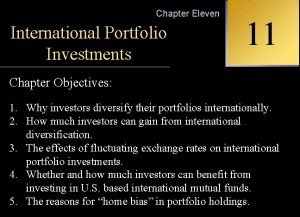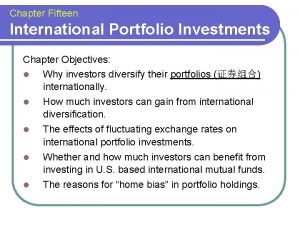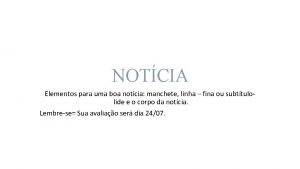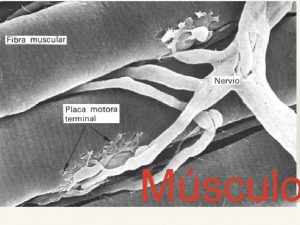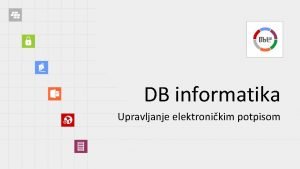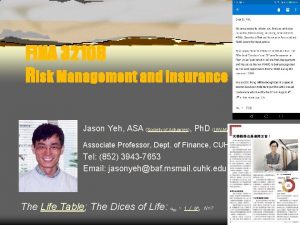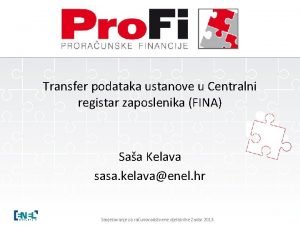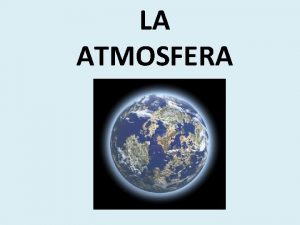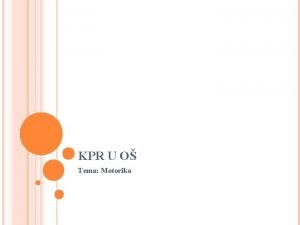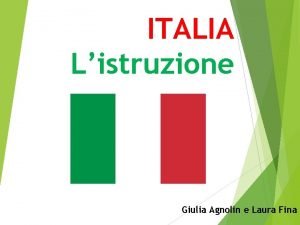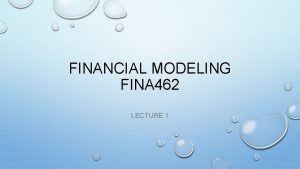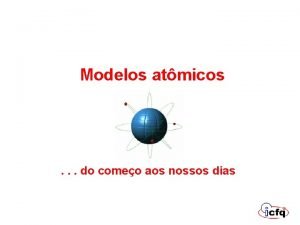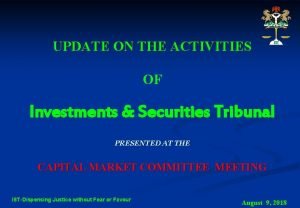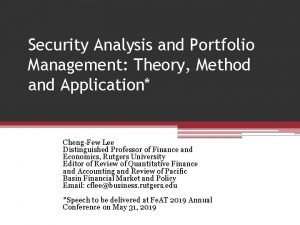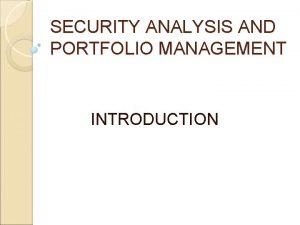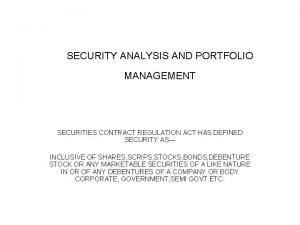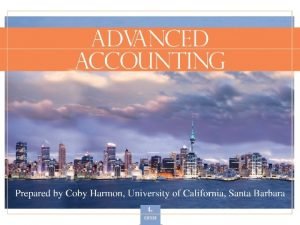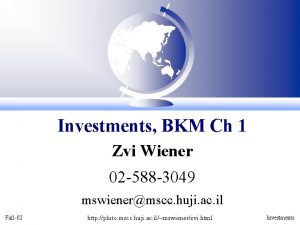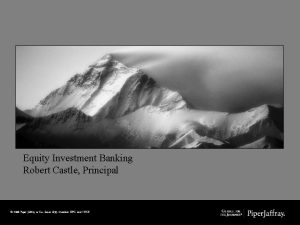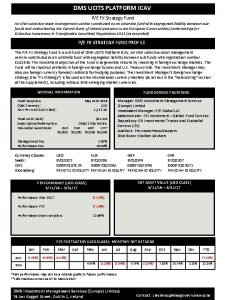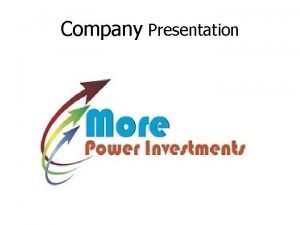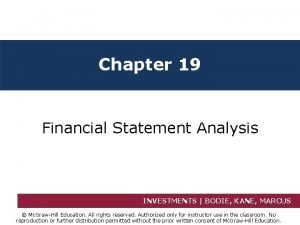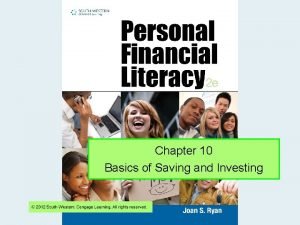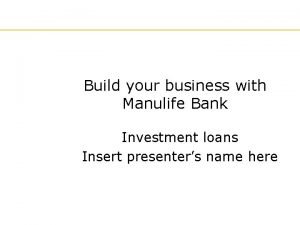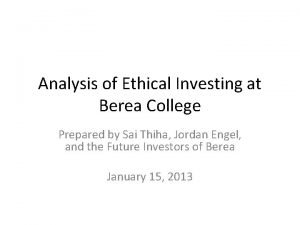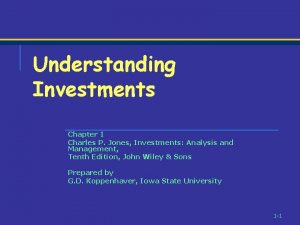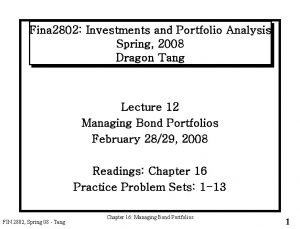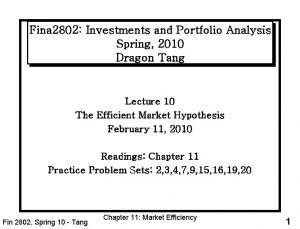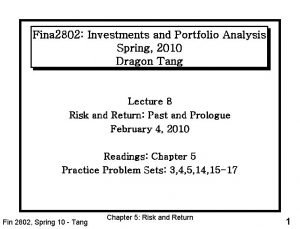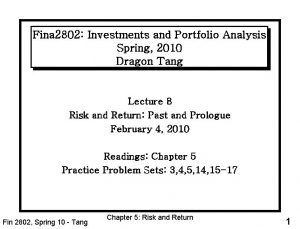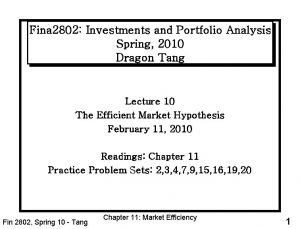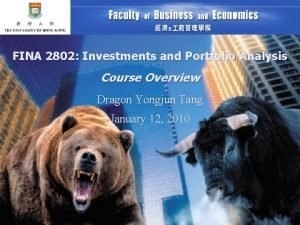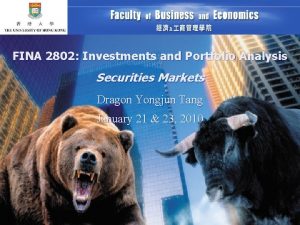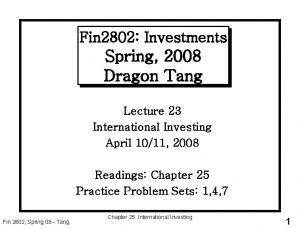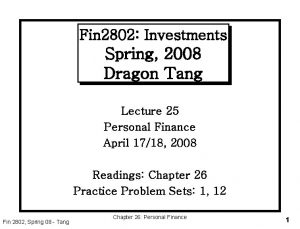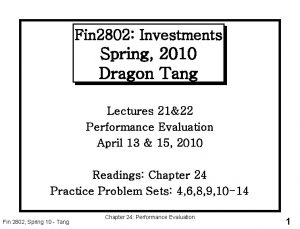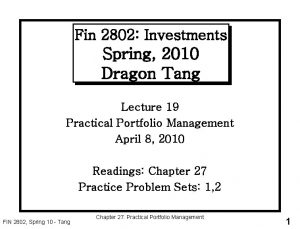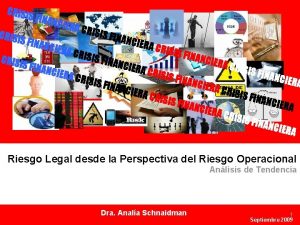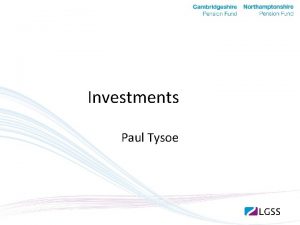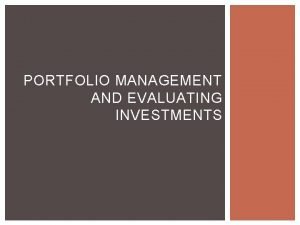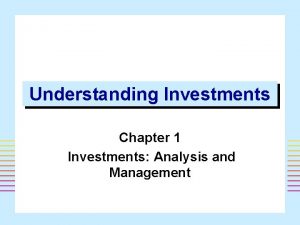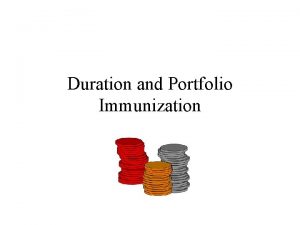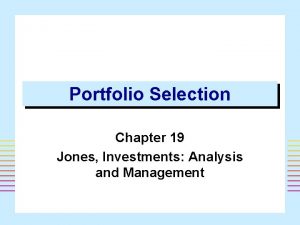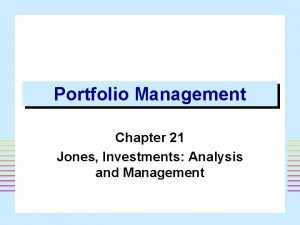Fina 2802 Investments and Portfolio Analysis Spring 2008










































- Slides: 42

Fina 2802: Investments and Portfolio Analysis Spring, 2008 Dragon Tang Lecture 11 Bond Prices/Yields and Yield Curve February 25/26, 2008 Readings: Chapter 14 Practice Problem Sets: 4, 5, 7, 8, 9, 10, 13, 35, 36 FIN 2802, Spring 08 - Tang Chapter 15: Yield Curve 1

Bond Prices and Yields Objectives: 1. Analyze the relationship between bond prices and bond yields. 2. Calculate how bond prices will change over time for a given interest-rate projection. 3. Identify the determinants of bond safety and rating. 4. Analyze how callable, convertible, and sinking fund provisions will affect a bond's equilibrium yield to maturity. 5. Define the yield curve and study its properties 2

Bond Characteristics • Face or par value • Coupon rate – Zero coupon bond • Compounding and payments – Accrued Interest • Indenture FIN 2802, Spring 08 - Tang Chapter 15: Yield Curve 3

Provisions of Bonds • • • FIN 2802, Spring 08 - Tang Secured or unsecured Call provision Convertible provision Put provision (putable bonds) Floating rate bonds Chapter 15: Yield Curve 4

Bond Ratings Moody’s S&P Aaa(1, 2, 3) Aa A Baa AAA AA A BBB Ba B Caa Ca C D BB B CCC CC C D Investment grade Speculative grade (junk bonds) 5

Present Value today of an amount to be received in the future FVn = payment received at time n n = number of periods r = interest rate period PVn = Present value 6

Present Value. Example: What is the present value of $1 to be received (or paid) in 10 years if the annual interest rate is 5%? 7

Bond Pricing Bond value =Present value of coupons + present value of par value 8

Bond Pricing Example: Find the value (price) of a 30 -year semiannual $1, 000 par bond with coupon rate of 8% when similar bonds are also paying 8%. Using formula or PRICE function in Excel. 9

Bond Pricing Example: Find the value (price) of a 30 -year semiannual $1, 000 par bond with coupon rate of 8% when similar bonds are also paying 10% (I. e. , 5% semi-annually). 10

Bond Pricing Market interest rates rise Þ bond prices fall 11

Bond Pricing Example: Find the value (price) of a 30 -year semiannual $1, 000 par bond with coupon rate of 8% when similar bonds are also paying 6% (I. e. , 3% semi-annually). 12

Bond Pricing Market interest rates fall Þ bond prices rise 13

Bond Pricing and Market Interest Rates Market Maturity Coupon Interest Value Rate Bond Price $ 1, 000 8% 8% $1, 000. 00 $ 1, 000 8% 10% $ 810. 71 $ 1, 000 8% 6% $1, 276. 75 14

Bond Pricing: Convexity - An increase in the interest rate results in a price decline that is smaller than the price gain that results from a decrease of equal magnitude in the interest rate. Bond Price Flatter Market Interest Rate 15

Bond Pricing: Maturity and Coupon The longer the time to maturity/lower coupon rate of a bond, the greater the sensitivity of price fluctuations to the interest rate. Maturity 1 yr 10 yrs 20 yrs 30 yrs FIN 2802, Spring 08 - Tang 4% $1, 038 1, 327 1, 547 1, 695 Price of a 8% Coupon Bond when Mkt Interest Rate is 6% 8% 10% 12% $1, 019 $1, 000 $981 $963 1, 148 1, 000 875 770 1, 231 1, 000 828 699 1, 276 1, 000 810 676 Chapter 15: Yield Curve 16

Yield to Maturity Yield to maturity is a measure of the average rate of return that will be earned if the bond is held to maturity. YTM assumes reinvestment of the coupons at the yield to maturity. YTM is the solution (IRR) of : 17

Yield to Maturity Example: Find the YTM of a semiannual bond with a price = $1, 276. 76, 30 years left to maturity, and a coupon rate of 8%. (Use trial and error method. In Excel: use Solver or YIELD function). 18

Corporate Bonds Promised versus Expected Yield • The promised or stated yield is the maximum possible return if held to maturity. • The expected yield weights the promised yield by the probability of future default. • The default premium is the differential in promised yield between a corporate bond a government bond. 19

Holding Period Return Where Bt = Bond Price at time t Bt+1= Bond Price at time t+1 FIN 2802, Spring 08 - Tang Chapter 15: Yield Curve 20

Bond Prices over Time Coupon bonds • Premium bonds move towards par as they approach maturity • Discount bonds move towards par as they approach maturity 21

Spot Rates and the Term Structure • Spot rate: rate used to discount a cash flow at a point in time – YTM on a zero-coupon bond maturing at that time • Term structure of interest rates, represents the variation of spot rates over terms to maturity • Yield curve often refers to the variation of YTM over terms to maturity FIN 2802, Spring 08 - Tang Chapter 15: Yield Curve 22

Treasury Yield Curves FIN 2802, Spring 08 - Tang Chapter 15: Yield Curve 23

Theories of Term Structure of Interest Rates • If future interest rate is uncertain, we need a theory of the term structure of interest rates to explain changes in bond prices and in turn in interest rates • Three major theories of yield curve – Expectation Hypothesis – Liquidity Preference Hypothesis – Segmented Market Hypothesis – Combination (Synthesis) FIN 2802, Spring 08 - Tang Chapter 15: Yield Curve 24

The Expectation Hypothesis Example: Suppose that 2 -year bonds offer yields to maturity of 6%, and 3 -year bonds have yields of 7%. What is the expected one-period rate for the third year? 25

Forward Rates • From the current term structure of interest rates, it is possible to glean the market expectation of future interest rates. These expected future spot rates are called forward rates. • With forward rates, we can estimate bond prices at a future date. • Forward rates are used most often in pricing fixed income derivatives, and in particular, swap contracts. FIN 2802, Spring 08 - Tang Chapter 15: Yield Curve 26

Figure 15. 2 Two 2 -Year Investment Programs FIN 2802, Spring 08 - Tang Chapter 15: Yield Curve 27

Calculating Forward Rates from the Term Structure • Consider two alternative investments: – Buy a 3 -year zero-coupon bond – Buy a 2 -year zero-coupon bond and then after 2 years buy another 1 -year zero-coupon bond • Investors will be indifferent among these two alternatives if they have the same expected return; i. e. , if we end up with $100 either way, the current initial investment should be the same. FIN 2802, Spring 08 - Tang Chapter 15: Yield Curve 28

Calculating Forward Rates from Term Structure (cont. ) • Alternative one: – The cost is • Alternative two – The cost is • Costs in two alternatives should equal, this implies FIN 2802, Spring 08 - Tang Chapter 15: Yield Curve 29

An Example • 2 -year spot rate: 8. 995% • 3 -year spot rate: 9. 660% • 1 -year forward rate 2 years from now is FIN 2802, Spring 08 - Tang Chapter 15: Yield Curve 30

Figure 15. 3 Short Rates versus Spot Rates FIN 2802, Spring 08 - Tang Chapter 15: Yield Curve 31

FIN 2802, Spring 08 - Tang Chapter 15: Yield Curve 32

FIN 2802, Spring 08 - Tang Chapter 15: Yield Curve 33

Forward rate • Frequently, you will see forward rate expressed as f(t, t). This indicates a yield on a forward loan agreement struck today. The loan period is from future time t until t+t. • Generally, FIN 2802, Spring 08 - Tang Chapter 15: Yield Curve 34

Future Bond Prices and Forward Rates • Recall that when we need to calculate the expected bond price sometime in the future, we need to know the expected spot rates at that time FIN 2802, Spring 08 - Tang Chapter 15: Yield Curve 35

Expectation Hypothesis • Current forward rate equals the market consensus expectation of future short term interest rate. – If the current term structure of interest rates is upward (downward) sloping, then the prediction of future spot rates is that they will be increasing (decreasing). – Example: 6 Mo. spot rate = 6. 03, 1 year spot rate = 6. 23 then 6 -mo. forward rate in 6 mo. is 6. 43. • Current long-term rate is a geometric mean of current and future short-term interest rates expected to prevail over the maturity. • This implies that an investor is indifferent to holding either short term or long term bonds. FIN 2802, Spring 08 - Tang Chapter 15: Yield Curve 36

Liquidity Preference Hypothesis • Suppose an investor, who prefers liquidity, prefers short term bonds. – There are two bonds available, a one-year zero with yield 4. 5%, and a two-year zero 5. 0%. As she prefers the one-year bond, after one year, she reinvests in another one-year zero at thenprevailing yield. The expected return from holding two consecutive one-year bonds is and the expected return from holding the two-year zero is – Then to entice her to hold the two-year bond, it has to be that i. e. , there is a positive liquidity premium for the long bond. – This theory assumes that short-horizon investors dominate in the market? (What if long-horizon investors dominate? ) FIN 2802, Spring 08 - Tang Chapter 15: Yield Curve 37

Segmented Market Hypothesis • Individual and institutional investors have their preferred maturities as they hedge against their liabilities – Preferred Habitat Theory • Long-term bonds and short-term bonds are traded in essentially distinct or segmented markets • No longer a popular view, as market participants (and arbitrageurs) invest in all segments to search for more profitable opportunities. FIN 2802, Spring 08 - Tang Chapter 15: Yield Curve 38

Yield Curve. Combination of Theories Example: Suppose the liquidity preference theory predicted a 4% rate for 1 -year securities and a 6% rate for 2 -year securities. However, investors expected the interest rate in year 2 fall by 2%. Liquidity Preference Yield Curve Yield 6% 4% Combined Yield Curve 1 2 Maturity 39

“Modern” Term Structure Theories • Using mathematical models to describe the movement of interest rates directly. • Assuming that one or several factors driving the interest rate movement as well as the evolution of the term structure • Can be used to price interest rate derivatives, such as options on bonds, swaps, etc. FIN 2802, Spring 08 - Tang Chapter 15: Yield Curve 40

Summary and Chapter Problems • Basic features of bonds • Bond yields, in particular, yield-to-maturity • Default risk and credit spreads • • Spot rates and the term structure Forward rates Theories of the term structure Next class: managing bond portfolios FIN 2802, Spring 08 - Tang Chapter 15: Yield Curve 41

Summary • Inverse relationship between bond prices and bond yields • Premium and discount bonds • Corporate bonds and default risk • Term structure of interest rates Expectations theory Liquidity preference theory • Next Class: Managing Bond Portfolios 42
 International portfolio investments
International portfolio investments International portfolio analysis
International portfolio analysis 2008 2008
2008 2008 Spring, summer, fall, winter... and spring (2003)
Spring, summer, fall, winter... and spring (2003) Spring to summer months
Spring to summer months Digital portfolio vs printed portfolio
Digital portfolio vs printed portfolio Turbotarara
Turbotarara Manchete linha fina e lide
Manchete linha fina e lide Función del músculo cardíaco
Función del músculo cardíaco Fina potpisni modul
Fina potpisni modul Fina jrr
Fina jrr Jason yeh cuhk
Jason yeh cuhk Registar zaposlenika
Registar zaposlenika Atmosfera
Atmosfera Fina tema
Fina tema Laura fina
Laura fina Define fina
Define fina Rutherford bombardeou uma fina lamina
Rutherford bombardeou uma fina lamina Ministerul fina
Ministerul fina Investment and securities tribunal
Investment and securities tribunal Chapter 11 real estate and other investments
Chapter 11 real estate and other investments Security analysis and portfolio management project
Security analysis and portfolio management project Security analysis and portfolio management project
Security analysis and portfolio management project Investment analysis and portfolio management notes
Investment analysis and portfolio management notes Importance of security analysis and portfolio management
Importance of security analysis and portfolio management Risk in security analysis and portfolio management
Risk in security analysis and portfolio management Scope of investment analysis and portfolio management
Scope of investment analysis and portfolio management Investment analysis and portfolio management course
Investment analysis and portfolio management course Consolidated retained earnings
Consolidated retained earnings Fundamentals of analyzing real estate investments download
Fundamentals of analyzing real estate investments download Kieso chapter 17
Kieso chapter 17 Investments bkm
Investments bkm Investments bodie kane marcus
Investments bodie kane marcus Loarre investments
Loarre investments Strategie consulting dms
Strategie consulting dms More power investments
More power investments Investments bodie kane marcus summary
Investments bodie kane marcus summary Chapter 10 basics of saving and investing
Chapter 10 basics of saving and investing Manulife bank investment loans
Manulife bank investment loans Investments berea
Investments berea Financial accounting chapter 6
Financial accounting chapter 6 Bus-123 introduction to investments
Bus-123 introduction to investments Understanding investments
Understanding investments
